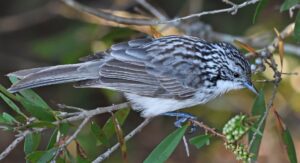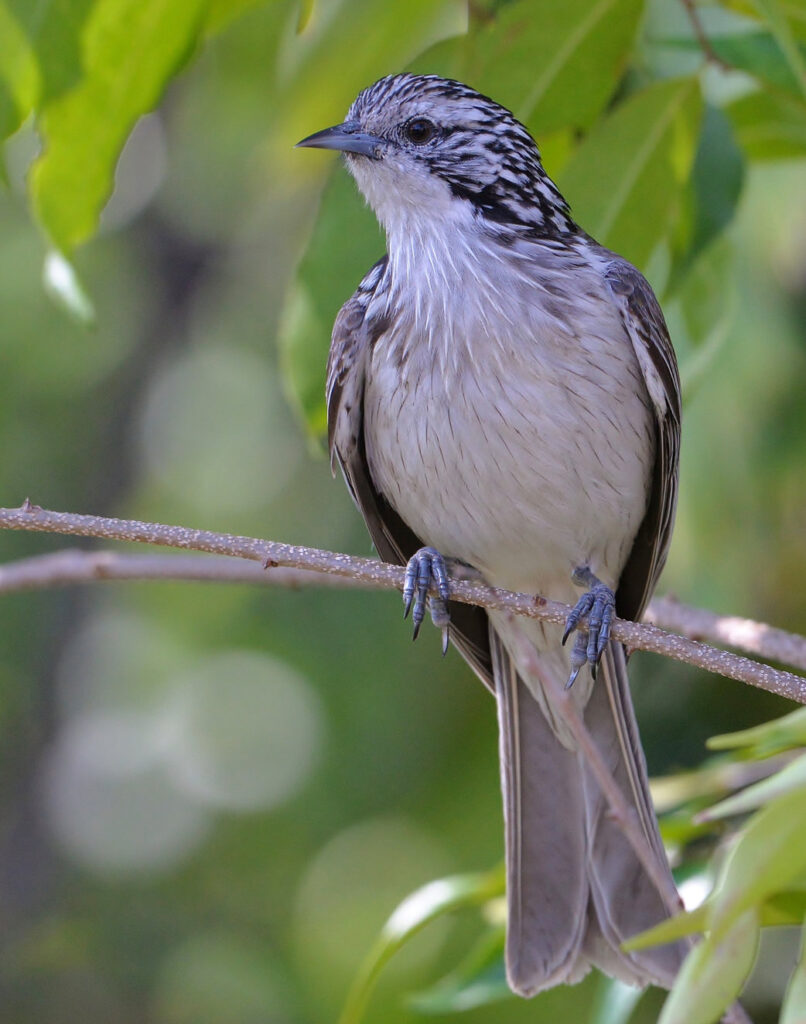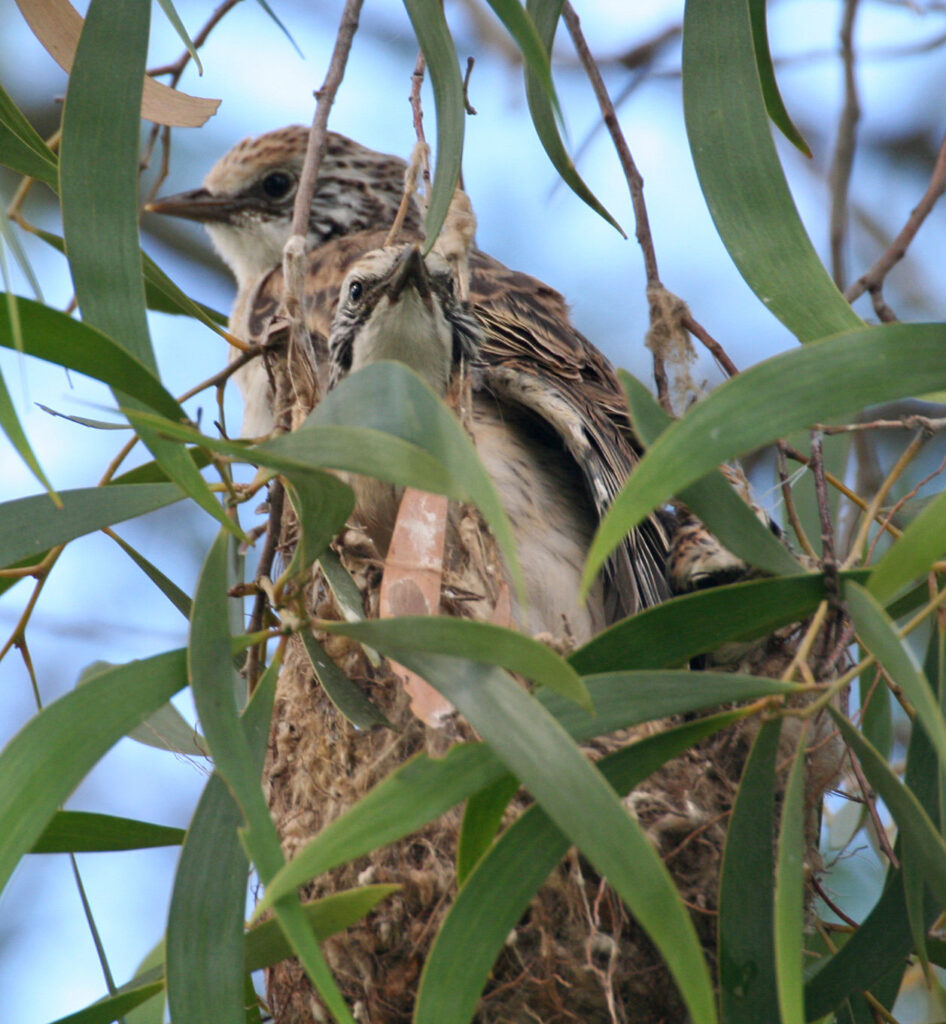The Striped Honeyeater (Plectorhyncha lanceolata) is a familiar bird in eastern Australia, particularly in Queensland and New South Wales where most of its range lies. Although a medium-sized honeyeater species, it tends to be furtive and is a bird that is heard a great deal more than it is seen. Its loud, clear, rollicking call is often given when the bird is perched in dense vegetation.

Not surprisingly given its distinctive appearance, the Striped Honeyeater is the sole member of its genus (Plectorhyncha), a name which reflects its pointed bill. Its closest relative (and similarly in a monotypic genus) is the Painted Honeyeater (Grantiella picta). Together these two birds are more distantly related to the genus Philemon (friarbirds), and more distantly again to Xanthotis (Macleay’s and Tawny-breasted Honeyeaters).

In his 1964 book on Australian honeyeaters, Officer described the Striped Honeyeater as “An inhabitant of the hotter inland parts of Eastern Australia…”. An inspection of Atlas and eBird records certainly supports this observation, but Striped Honeyeaters are also regularly found in coastal regions, particularly between southeast Queensland and Newcastle. That has not always been the case. I saw my first Striped Honeyeater in the 1980s, and at that time it was a scarce bird around Brisbane. In fact, my sighting was made on one of the regular Marburg outings that Graham Leach used to lead. The possibility of sighting a Striped Honeyeater was one of the main drawcards of those trips. However, in more recent times, since about the year 2000, the Striped Honeyeater has become much more common in Brisbane. Indeed, for a decade or so it was one of the birds I most frequently recorded in my suburban yard on the northern edge of Brisbane. Over the last 10 years those sightings have become far less common in our yard itself, but the species remains very common in the southeast Queensland region.
While the Striped Honeyeater will eat nectar, fruit and seeds, it predominantly feeds on invertebrates, with insects, insect larvae and spiders its favoured food. Most of the time it gleans its food from foliage, but sometimes it will take prey from branches and trunks, using its bill to probe under bark and into crevices. Sallying is sometimes used to take food from outer foliage. Several observers have noted Striped Honeyeaters collecting prey, then taking it to a branch or post where the birds holds the prey down with one foot while dismembering it will its beak. Such behaviour is very unusual in honeyeaters. Striped Honeyeaters can form small foraging parties, and sometime they will feed in mixed-species flocks, particularly with other honeyeaters.

The breeding biology of the Striped Honeyeater is interesting and it is one of the few Australian honeyeaters where both parents share the incubation duties. The nest is a relatively bulky, deep and thick-walled structure consisting of plant down or wool intertwined with grass stems, rootlets and sometimes incorporating feathers into its outer surface. The incorporation of synthetic fibres into the nest has also been described. The nest is usually well concealed in foliage and is often found at the end of drooping branches, such as those of eucalypts, Callitris, casuarinas or Melaleuca. Pairs usually nest singly, but communal breeding has been recorded. Interestingly, on quite a few occasions Striped Honeyeaters have been found nesting in close proximity to the nests of Grey Butcherbirds, and occasionally with other species. Presumably this affords the nest some protection. The parent birds themselves will vigorously defend their nest if required. Usually three eggs are laid, and these are dull white with darker speckling.
The Striped Honeyeater is generally found singly or in pairs, although sometimes small flocks will form, as noted above. These are most often observed in the non-breeding season. Cooperative breeding has been noted on one occasion with three birds attending a nest at Meandarra on the Darling Downs. Although the birds will defend their nest, they do not appear to be particularly territorial, but this is one of the areas that requires further study.
Despite being a familiar bird, there are many aspects of the life history of the Striped Honeyeater that are not well understood, or are based on limited data, and the patient observer could make an important contribution to our understanding of this species. Some of the areas that require attention are its breeding biology, social behaviour, movements and food sources.
The information in this article was drawn from
- Driskell and Christidis (2004; Molecular Phylogenetics and Evolution 31:943-960)
- Higgins et al. (2001; HANZAB, Volume 5)
- Longmore (1991; Honeyeaters and their Allies. The National Photographic Index of Australian Wildlife)
- Officer (1964; Australian Honeyeaters. The Bird Observers Club)
- Wood and Ley (2005; Australian Field Ornithology 22:88-103)
I thank Richard Noske for providing several papers as well as some of his thoughts on the biology of the Striped Honeyeater.


